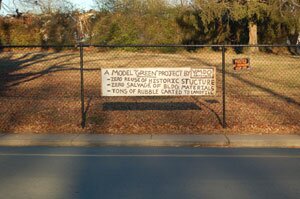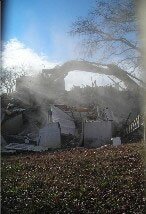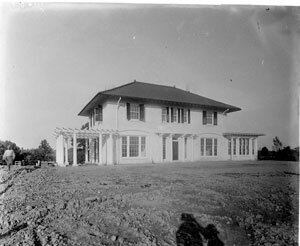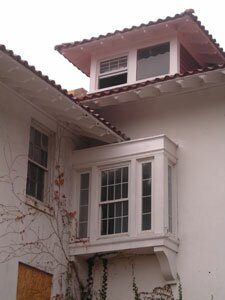ONARCHITECTURE- Demo dilemma: When is a house worth saving?

Preservation protest: This homemade sign was spotted hanging on the fence around the demolished Beta House on January 3, 2008.
Like a patient on life support with a mysterious disease, the distinctive Compton House at 124 Maury Avenue, more commonly known as Beta House, awaited a final diagnosis for months last year while those hoping for a cure clashed with those wanting to pull the plug.
Preservationists argued that the Beta House, designed by famed local architect Eugene Bradbury, was an architectural treasure worth saving, despite lacking official historic designation, while others argued that it was a beat-up old frat house that deserved the wrecking ball.
However, despite strong objections from local preservationists as well as from City Council– who denied additional bond financing to the property's owner, the Jefferson Scholars Foundation because they were not satisfied with efforts to preserve the house– the private residence and fraternity house was demolished on December 27, 2007.
Afterwards, Charlottesville's own preservation and design planner, Mary Joy Scala, called the reduction of the Beta House to a pile of rubble "a lost opportunity to demonstrate that preservation is the cornerstone of sustainability." Former mayor David Brown suggested that the Foundation had misled City Council, pointing out that there was no mention of a possible demolition when the group was seeking $18 million in bond financing to build its new $21 million headquarters on the site. Brown told the Hook in January 2008 that Council members believed that a foundation bearing Jefferson's name and associated with UVA would surely be dedicated to historic preservation. "Who would have thought it was their intent to tear it down?" he asked.
During a January 7 City Council meeting, Dave Norris, Satyendra Huja, Holly Edwards, and Julian Taliaferro all appeared to be in favor of better protecting historic properties based on the city's experience with the Beta House.
Responding to disgruntled preservationists in the crowd, Brown said, "I deeply regret we didn't take a closer look."
The incident also prompted the city to develop a new category of historic oversight, a kind of "historic district lite" to provide a better level of protection for buildings like Compton House. In fact, during that January 7 Council meeting, Scala presented a list of over 100 historic and architecturally significant properties to be considered for protected status, such as the Coca Cola bottling plant on Preston Avenue and the Fry's Spring Service Station (which is currently for sale). "A successful historic preservation program must rely on regulation to prevent worst-case scenarios like destruction of the Beta House," she told Council.
Meanwhile, work is scheduled to begin on the new Jefferson Scholars headquarters this summer. The Foundation is also seeking the coveted gold-level certification from the U.S. Green Building Council, a nationally recognized standard of excellence for environmentally friendly construction.
Before Council, UVA architectural historian Daniel Bluestone, who began encouraging the Jefferson Scholars to preserve the building shortly after they purchased the property, called the demo "disgusting" and "a day of vandalism in our commons" that was paid for with public funds. "We are all responsible," he said, "and we need a strategy to hold on to the heritage of our city." He ended by handing each councilor one of the expensive terra cotta roof tiles from the demolished Compton House to be used as a paperweight and a reminder.
The demo also inspired some creative vandalism from preservationists. A makeshift sign (see photo) appeared on the fence surrounding the property mocking VMDO Architect's "model green project."
Project architect Bob Moje of VMDO called the sign a "juvenile prank" by someone poorly informed about the project.
"This is a LEED [a recognized industry standard for green building] project, and considerable effort is being made to make the project green and environmentally friendly," said Moje. "VMDO is a leader in this area, and our record speaks for itself."
"An important issue raised by the demo involves the relationship between preservation and 'green' building," preservation activist Aaron Wunsch countered. "This is a hot topic in the preservation world right now. Is it possible to demolish a massive historic structure and then declare its successor environmentally correct? The answer, I think, hinges on what preservationists call 'embodied energy'– the amount of labor and resources that a given building consumed in its production."
According to Bluestone, the 1913 Compton House was one of the most important Charlottesville structures of the last century. Not only was it one of many Bradbury designs in town– joining St. Paul's Church, the Kearney Mansion atop Lewis Mountain, the entrance building at UVA, three houses on the east side of Rugby Road at the intersection with Rugby Avenue, the Bank of America building on the Downtown Mall, the Chi Phi fraternity house, and Four Acres and the Goodwin House on Rugby Road extended– but it was a unique example of Bradbury's understanding of Jefferson's ability to root his designs in the topography and geology of a site, Bluestone said.
During a public hearing on the project in September 2007, Jefferson Scholars Foundation president James Wright said that preservation might not be an option because the Beta House frat brothers had been so hard on the structure, to which Bluestone responded later in the Hook, "If this house is demolished, the Jefferson Scholars Foundation will have turned out to be much harder on this house than decades of frat brother partying."
"We are not, as a foundation, in the business of historic preservation," Wright told City Council members at a September 17 meeting. Wright– who, according to several Council members, appeared physically agitated by Council's decision to block the financing– said the Foundation had not yet decided what to do with the building.
"It's definitely a significant historic structure," mayor David Brown later told the Hook, "and we want to know what they plan to do before we approve the bond issue."
That answer came November 28. Following a diagnosis from Moje, who declared the house too damaged to make historic renovation practical, the Jefferson Scholars Foundation applied for a permit for demolition. The Foundation chose to avoid another confrontation with City Council by seeking the additional funding elsewhere.
Although Moje admitted that the structure was sound, he said the interior had been "decimated by 50 years of fraternity use." Moje described stair treads completely worn away, rooms haphazardly reconfigured, and completely unworkable electrical and plumbing systems.
"You wouldn't be restoring the house, you'd be recreating it," he said, "and to what purpose?"
Preservation-minded people might have a ready answer. Considering the cacophony of horrid designs along JPA on the way to Maury, the stylish overlapping angles of Beta House's red terra cotta roof, along with such flourishes as its pergola and sun porch made it especially soothing, like spotting a vacant Mediterranean villa after walking past a shoreline of fish shacks.
"Of course, people have a normal bias that something should be saved if it's old," said Moje. "And if it's a close call, I'm all for giving a house the benefit of the doubt, for not demolishing it. But this was not a close call.
"Sure, it had a pretty good architect," he said. "As an architect, I can appreciate that. But it's not even the best example in town of Bradbury's work." And as Moje pointed out, the doctor for whom Bradbury designed the house had moved into another, better house designed by the architect on Rugby Road, leaving the Compton House to the mercy of a thousand keg parties. Not exactly an illustrious history.
Still, there's a lot to be said for refusing to give up on a sick patient.
On the opposite side of town at a more humble address, a builder was putting the finishing touches on a recovering patient, an old house that many architects and builders had considered beyond repair.
"If a house is still standing," said Michael Courts, a project manager for Lithic Construction, who admitted he wasn't familiar with the Compton House, "then it's salvageable. If someone is truly interested in saving it, you can. With today's technology, you can do anything with an old house."
Courts should know. About a year ago, the Nimmo House on Hartman's Mill Road off Ridge Street was nothing but a rotting shell. Because the house is one of 65 structures the City lists as Individually Protected Properties, the owners– unaware of the historic designation when they bought the property for a mere $18,000 in 1994– were not allowed to demolish it. However, the house was in such bad shape that every builder and architect they approached told them it could not be restored.
However, thanks to Preservation Piedmont, who originally argued against the demo permit, just before Christmas the owners moved into a unique and beautifully restored house, and along the way picked up the 2007 Private Project of the Year Award from APVA Preservation Virginia.
While the Jefferson Scholars Foundation wants to get LEED certification for its new headquarters, Courts points out that you can't get much greener than saving an old house, which is essentially recycling something instead of throwing it away.
While Courts admitted that such recycling can be expensive, and that a builder must be familiar with old houses to know how to proceed, he said the biggest deterrent to historic preservation is simply the fear of the unknown.
"It's hard to know what you'll run into," he says. "If we jack up the house, will all the stucco fall off? It makes it hard to give people a good estimate of the costs."
Believe it or not, that was something Moje was inclined to agree with. If, like the Nimmo House, someone had wanted to restore the Compton House as a private residence, he thought that could work– "at considerable cost," he adds, "but you could do it."
However, Moje pointed out that restoring the Compton House as part of the larger Jefferson Scholars Foundation project simply didn't make practical sense given the condition of the building and the scope of the new project. And he bristled at the continuing "knee-jerk" reaction of some preservationists– particularly the idea that demolishing the house was a crime.
"I wish people would be as concerned about what's being built," he said, "as they are about what's being taken down."

After the residence stood for 93 years at 124 Maury Avenue, a lone back-hoe brought down Beta House in a matter of hours on December 27, 2007.
FILE PHOTO BY DAVE MCNAIR

Eugene Bradbury's historic Robert Compton House on Maury Avenue was designed in 1913.
ALBEMARLE CHARLOTTESVILLE HISTORICAL SOCIETY

The back of Beta House shows Bradbury's attention to detail and symmetry.
FILE PHOTO BY DAVE MCNAIR
#